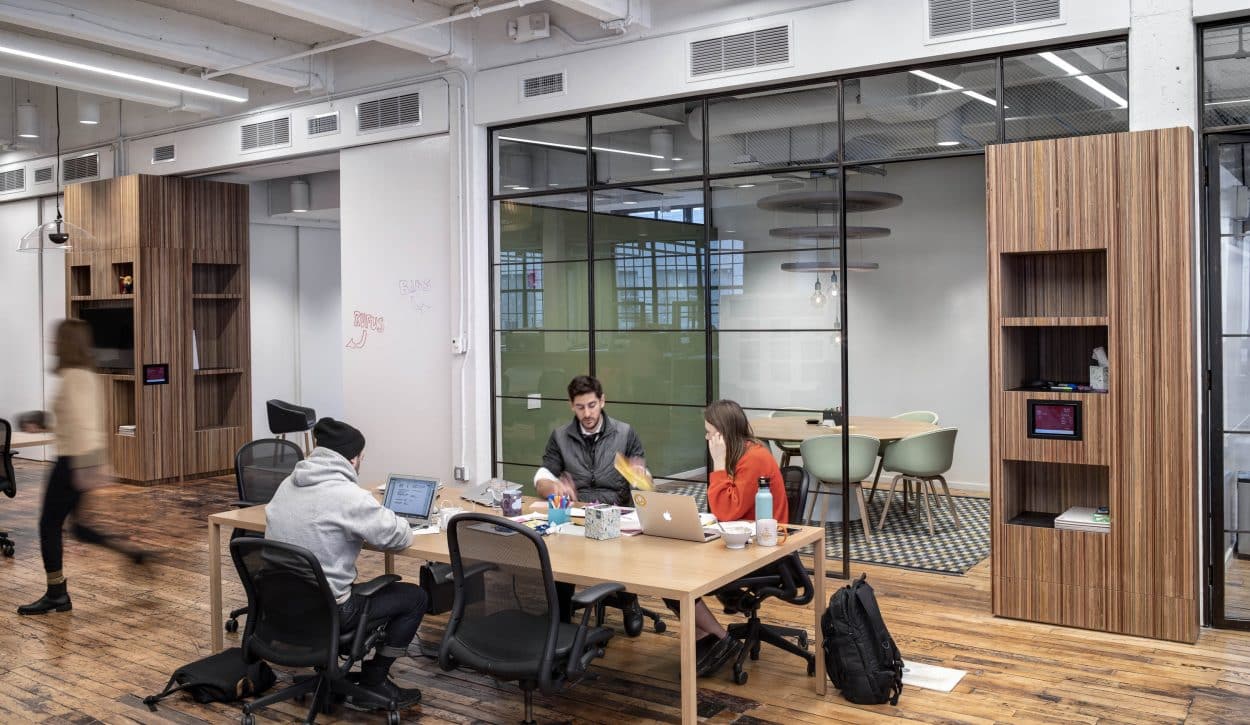New York-based architecture and interior design firm Design Republic gives a preview of what is to come for offices, from shifting behaviors among employees and clients to design upgrades and revisions that would put hygiene at the forefront after the coronavirus pandemic.
As people are starting to get back to work, offices have transformed with short-term fixes that place hygiene at the top of the priority list. How will offices change in the long run?
Design Republic, a highly experienced design firm specializing in corporate workplace, retail, commercial and media technology design, is currently doing research that explores the possible changes in workplace behavior that would lead to significant alterations in office space design for their many clients which include Amazon, LinkedIn, YELP and Take 2 Interactive Software amongst many others.
ArchiExpo e-Magazine interviewed Gabriel Hernandez, Principal and Business Manager of Design Republic, and one of the firm’s principals from the Executive Committee – Design, Vincent Iacobellis, to know more.
ArchiExpo e-Magazine: What kind of changes does Design Republic expect for the future of office design and commercial retail spaces, post-pandemic?
Gabriel Hernandez: While it is too early to tell, most companies are not dramatically changing their workplace strategies in 2020 and 2021, but instead, they are waiting to see how behaviors change. However, they all accept that work from home as an employee benefit is here to stay. It will provide an opportunity to explore new ways of working and test the limits of technology to ensure a work-life balance and a sense of safety to employees. Strategies such as de-densification of the office space, ubiquitous video technology and a much more elevated social / community experience when in the office for socialization and sustainability of company culture, training, professional development, mentoring and collaboration; these activities and engagements happen best when employees and teams are physically together.
READ our article Smart Office: A Post-pandemic Evolution for Workspaces.
Vincent Iacobellis: Retailers have been studying their operations as they plan their transition to reopening. Emphasis is being placed on providing a safe environment for their customers and sales associates alike. Store merchandising densification is being evaluated to reduce the number of merchandise fixtures to incorporate social distancing requirements which in turn will open circulation within the store environment. POS card scanning systems will be considered to mitigate the handling of a credit card during a purchase transaction. Hands-free sensor hardware technology. Finish materials at high touch point areas such as cash/wrap stations, incorporated lounge seating areas, and fitting rooms suites will be revisited to accommodate rigorous sanitizing requirements while maintaining sensitivity to aesthetics within designed environments].
Photo credits: What If? office by Design Republic. Courtesy of the firm.
ArchiExpo e-Magazine: Do you think that these changes will linger on and change the way how people behave and work in offices and commercial spaces in the next 10 years?
Hernandez: Work-life balance and employee workplace flexibility have been pervasive in the United States over the last ten years. The pandemic has accelerated this trend and has proven that employees and teams can be productive in the short term and maybe in the long term. Workplace flexibility will become the new normal for new entrants into the labor market and those veterans who have desired the flexibility for family connection but did not feel comfortable challenging social / work norms. Whether you are a millennial or a baby boomer, the need for friends, family, colleague connection and socialization is a top priority. Employees will learn new behaviors when socially interacting at work and when working in teams.
ArchiExpo e-Magazine: How do the teams of Design Republic cope/ work during the pandemic, in terms of dealing with existing clients and design projects?
Hernandez: Our studio was very prepared to handle this crisis. In hearing the news back in December 2019 / January 2020, we started to plan for a work from home strategy and communicating with the staff frequently. We purchased the hardware we needed so that the entire studio would have the necessary tools to perform their work, and we also moved to a universal video platform and cloud technologies. The human factor was initially a bit stressful because as human beings, we like routines, and the work from home deployment required that we adapt quickly. Nine weeks into this pandemic, we have found a new cadence of work, but everyone misses the human connection that video calls can never replace.
Iacobellis: Our current work from home set up allows studio members the ability to work autonomously while collaborating via scheduled video conferencing sessions with fellow colleagues, clients, consultants, and vendors.
ArchiExpo e-Magazine: Has your firm’s design plans and projects for your present clients changed in order to adapt to the current scenario?
Iacobellis: Absolutely, however subject to the stage of the project’s development. Those in the initial design stage are being re-planned to accommodate recent social distancing guidelines. Projects in construction are being retrofitted to the extent feasible to guidelines.
Take 2 office by Design Republic. Courtesy of the firm.
ArchiExpo e-Magazine: We saw that one of your recent projects with Take 2 Interactive Software included work and meeting spaces that were compartmentalized, with ergonomic chairs and tables that are distributed in the big office space which is ideal for working during the pandemic. Do we see this kind of design in future offices for your clients?
Hernandez: While T2 is a video gaming company with many creative gaming engineers, this project/location was populated with general administration personnel and licensing lawyers that required a space design that was very different from the typical technology company. In hindsight, this project lends itself to a better pandemic workplace solution with the compartmentalization of workstations and support spaces.
We recently completed a project for Starwood Capital, founder of Starwood Hotels. The nature of their personnel type is similar to Take 2.
Take 2 is a video gaming company, and this particular application of video technology is designed to showcase gaming products. This specific application may be seen in other projects we have designed such as Sidewalk Labs (a Google company), NBC Universal, Telemundo, MTV Networks.
ArchiExpo e-Magazine: There are studies that show building materials such as copper have antibacterial properties. Do we see more structures and fixtures in the office and retail spaces made from copper after the pandemic?
Hernandez: Copper and brass are being investigated as the science seems to indicate that the virus does not last very long on these metals. Still, there are many antimicrobial materials used in hospitals that are being investigated for commercial office applications. Other initiatives include more (additional) fresh air flow exchange in the air conditioning systems and better the filtration within the air conditioning systems. Our research has also uncovered that the addition of humidification into the air conditioning system during the winter months, which is typically not done but is beneficial in killing the virus.
Iacobellis: Irrespective of materials having antibacterial properties, finish materials in general at high touch point areas will be revisited. Rigorous sanitizing requirements will be at the forefront of designer’s minds for the foreseeable future when specifying materials while maintaining sensitivity to aesthetics within designed environments.
ArchiExpo e-Magazine: How do you envision the landscape of design from the workplace to retail in the next 10 years?
Hernandez: Technology solutions for working and shopping will accelerate. Work-life balance will take center stage by challenging the trust between employer and employee as they find new ways to be productive and profitable while building culture.
Iacobellis: Retail operational needs will impact the design of retail environments, touchless technologies will become commonplace, the interaction between customer and sales associate will evolve. Some retailers are already addressing an expanded personal shopping experience via appointment providing customer profiled curation offerings.













